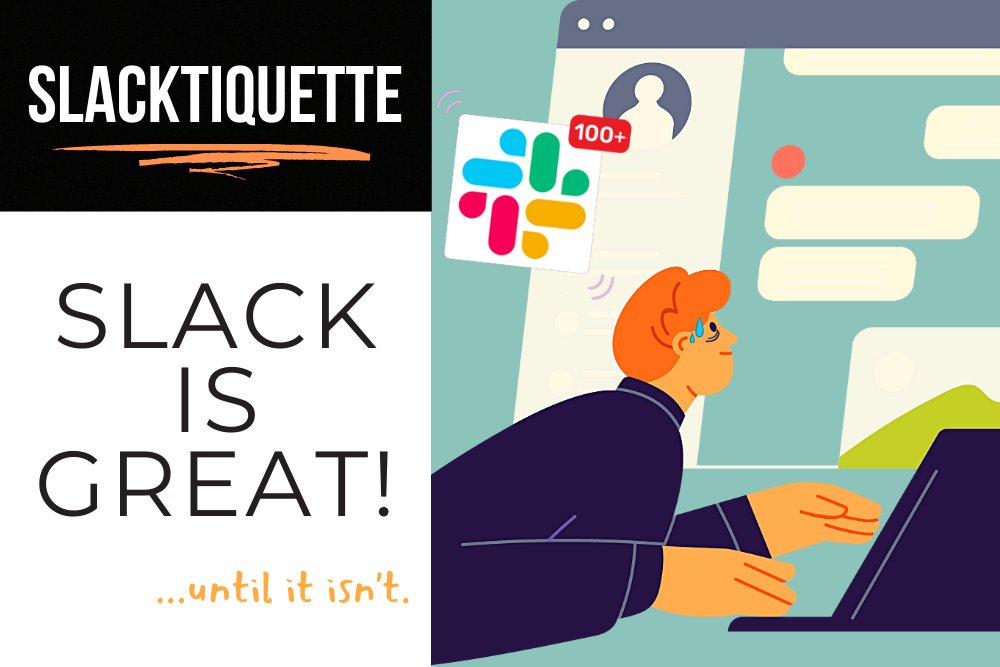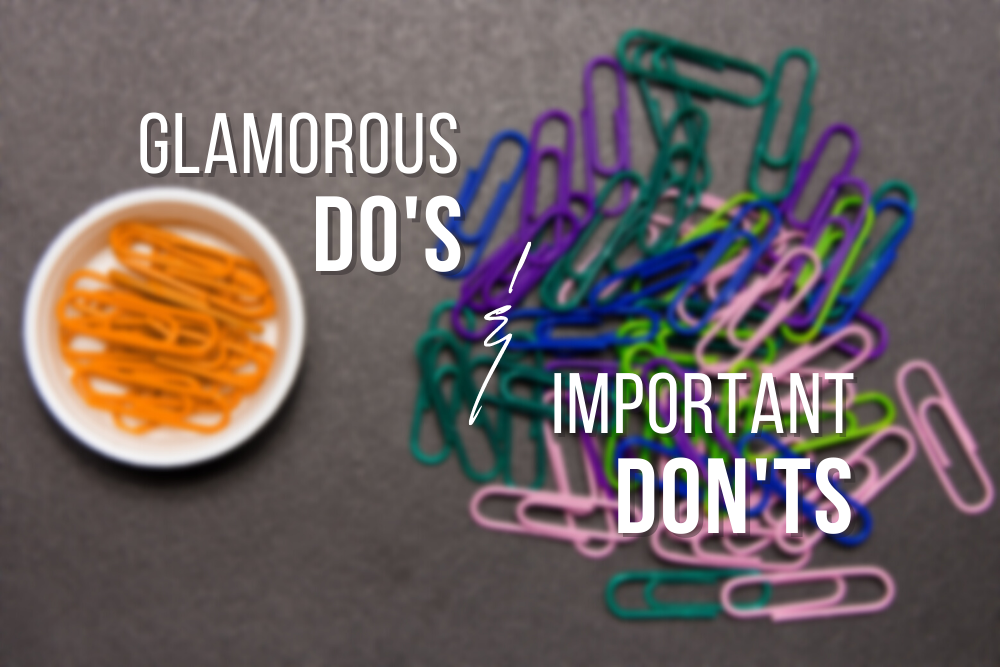Being able to collaborate complexly with your team in real time despite working from different locations, and even different continents, is truly a modern marvel that’s revolutionizing more than one industry. But what happens to the culture that is built through in-person conversations and brick-and-mortar layouts that help design how all of those on-site employees work together?
Some of the natural boundaries that establish or are traditionally reinforced may transfer over, yet working from within a digital realm does introduce new X factors. Here we offer a comprehensive guide of best practices and points to consider when crafting your own company’s code of digital conduct for slack etiquette. And speaking from experience, although it can take work to get good Slacktiquette in motion, the payoff is profitable beyond the pocket!
In this article:
- Slack Origins
- Common Struggles
- Why a Revamp Matters
- Administrative DO’s
- Mindful Messaging DON’Ts
- More Insights
Slack Origins
With telecommuting going from a big ask pre-2020 to solidifying as a staple work institution during the pandemic, the need for a way to communicate efficiently, clearly, and in a timely manner across space (and time?) in a new era arose. Enter: Slack.
Slack has been around since 2009, going public in 2014. Originally created to be a whimsical multiplayer online game called Glitch, it swiftly morphed into a moderately successful and fun way for some early companies to conduct their business. And when 2020 hit, so did Slack’s record profits and popularity.
Common Struggles
So now we get to reap the playful rewards of this messaging system in the corporate world. Yay! As with all new shiny things with all kinds of possibilities and features, figuring out how to best utilize Slack has been a pain point expressed by many of its daily professional users. Common struggles that come up:
- Unclear channel names.
- Too many messages sent in a row.
- Lack of descriptions for channel purpose.
- Information overload / too many channels.
- Lack of organization, especially threading.
- Information published in incorrect channels.
- Difficulty finding past discussions or answers.
- Lack of clarity in which channels to ask a question.
- Unclear expectations about prioritizing response times.
- Trouble determining what is a must-read and what is optional.
- Missing important details; information scattered across various channels & DMs.
BACK TO TOP
Why a Revamp Matters
In a nutshell, overwhelm, confusion, and information overload. Expectations, protocol, and etiquette being unclear can cause exacerbation, wasted time, and yes, even the b word–burnout. Orbit, a young (2019) community growth platform, went through a Slack glow-up after some extensive analysis of their workers’ messaging habits and found that setting procedures and a little training made their communication go from messy static to digital clarity. Ulrich Sossou, currently an Engineer Manager at Orbit, had this eye-opening experience:
“Our Slack makeover revealed how the channel’s organization impacted collaboration.
One unexpected result was that we could react to customers’ demands way faster with better communication between customer-facing and product-engineering teams.
We learned that a virtual office layout has the same level of influence on company productivity and culture as a physical office layout.”
As the saying goes, the best time to plant a tree was 20 years ago; the second best time is now. Getting into good Slack habits sooner than later will not only help your employees and coworkers work more effectively, but it will also decrease their frustration which in turn frees up their brains to focus on innovation and performance instead of pain points.
BACK TO TOP
Administrative DO’s
Prioritize Clarity.
- Name channels appropriately.
- As your online communications grow and your business take off, having clear channel names due to purpose or project preemptively avoids confusion.
- Add channel descriptions upon channel creation, and update them as needed.
- Doing this minimizes channel confusion and accidental misuse!
- Inform people before adding them to new channels.
- Imagine you’re at work and suddenly your boss pulls you away from your desk and rolls you and your chair into another room full of chattering people and then walks away. Jarring, right? Letting whomever know you are about to put them into a new channel and giving them a brief on what their role is and channel expectations can be helpful to keep your workers in their flow.
Set the Standards.
- Set and update statuses: respect and create boundaries.
- Updating your status allows your colleagues to know if you’re at lunch, out of the “office”, and when they can expect you to receive their message. You can use this to indicate that you are in a meeting as well, so your co-worker isn’t left hanging awaiting your response. And, bonus for you, setting your status also protects your personal time and minimizes potential distractions while you’re unavailable.
- Set up a Slack notification schedule under “Preferences” ➡️ “Notifications.”
-
- You can have a set “do not disturb” schedule for off hours and the weekend so you don’t get pinged if you forget to set it. Setting your notification schedule from 8 a.m. to 6 p.m. allows messages to come through only during that window.
- If something urgent comes up, you can still send your message and elect to “notify anyway” the receiving party. This feature should be used very sparingly.
- You can have a set “do not disturb” schedule for off hours and the weekend so you don’t get pinged if you forget to set it. Setting your notification schedule from 8 a.m. to 6 p.m. allows messages to come through only during that window.
-
- Embrace asynchronous messaging.
- Normalize responding to non-urgent matters in an intelligently prioritized way. Meaning, a sent message often instantly reaches the other person’s inbox is not a reason to expect a prompt response. Proper time management can look like having times each day set aside for intentional message responding, which is a productivity and focusing tactic.
- Consider including a company slack etiquette guidelines as part of the onboarding process.
- Like individual people, every company has different defined rules and unspoken agreements on expected behavior and conduct, and the same is true for what they believe is good Slack etiquette. Making clear and easily accessible guidelines for employees, perhaps in a Google Doc or PDF, helps them know what is acceptable for themselves and others at all times on the platform for an agreeable work space.
Offer Relevant, Organized Spaces.
- Construct channels with prefixes for various channel types.
- Example: starting channels with #social- for connect channels, #ask- for help channels, #proj- for project-specific channels, #all- for any all-hands channels (like #all-announcements) that are required.
- Create a non-work channel (or a handful!).
- If there is designated space for watercooler talk, then fewer irrelevant chats will impede your business channels. And it’s great for having a “fun space” where your teams can better get to know one another and develop rapport and trust.
- Expressly request your teams utilize the threading feature to keep topics contained and pertinent information together.
- Coming back to a wall of messages that are bridled by topic can help a coworker who has been away come back and easily see what they missed and can choose relevant conversations to read. It also makes it easier to find solutions later on when using the search feature!
- Encourage and model use of built-in channel organizers
- Some great moves are pinning important messages and utilizing bookmark links in the channel toolbar.
- Indicate a channel lead/monitor.
- This person can be in charge of keeping an updated description of the channel and naming the current channel admin, ensuring relevant postings and redirecting people to the proper channels, etc.
BACK TO TOP
Mindful Messaging Don’ts
- Don’t ghost a request.
- DO acknowledge the message, even if you cannot work on it imminently. You don’t have to necessarily send a whole message. Having a key of emoji reactions, like a thumbs up ? or a checkmark ✅ to indicate you’re on it or eyes ? to indicate you are looking into something can be a quick click.
- Don’t use channels as DMs.
- DO send messages privately to help keep the channels clear for the rest of the team if there is only one person with whom you are sharing info.
- Don’t send multiple messages in a row or just a “hello” to start.
- DO include an entire message of information with readability, intent, and details about the purpose of contact to avoid distracting them as they wait for the meat and purpose of your message.
- Don’t spam unresponsive parties.
- DO wait to send a second message until they reply to your first. Chances are there is a reason they aren’t responding. In an emergency (take a beat, is it really an emergency?), seek out the next appropriate person to contact.
- Don’t bloat the channel with a longform message.
- DO use the post feature to share collapsible content! Or,
- DO make longer messages formatted for easy scanning by using bullet points, intelligent emoji placement, and taking a few extra minutes to trim off unnecessary words before posting.
- Don’t send all messages, no matter what time it is.
- DO send a scheduled message so you don’t forget! For teammates in different timezones or when you’re working through the weekend, you can compose and schedule it by clicking the dropdown arrow to the right of the send arrow in your chat box. This way no one is getting pulled into the work mindset so they can be more fully present in their life during time off.
- Don’t leave a conversation without warning.
- DO send a quick note to inform who you have been semi live-chatting with that you will be AFK for a while, and go enjoy that afternoon jaunt through some sunshine.
- Don’t overuse @channel/@here.
- DO use the @ feature when something is time-sensitive for the whole channel or when vital information is being shared.
- Don’t send every response to the channel from a thread.
- DO check the “Also send to #channel” box when threading a response under a parent post, IF: all channel members who may not be in the conversation need to address the message, the information is time sensitive, or it is urgent. Otherwise, this practice clogs the channel and can cause unnecessary distractions and irritation or overwhelm for your coworkers.
BACK TO TOP
More Insights
All in all, Slack is a great productivity enhancement and organizational platform when used with intention and teamwork. In fact, there are even more ways to use Social Media for Internal Communications (Slack, Instant Message), where our founder and CEO Derek Chew gives you some good stuff.
For more intel on how to build a strong digital company, Chew has also put together 10 ways to build a healthy remote marketing team that can be applied beyond the marketing industry to any remote business.
Now you’re a Slack etiquette master, you can go forth and be a professional Slacker with confidence!
BACK TO TOP
Tune in next week for the latest news in digital marketing from the Wolves’ Den.




